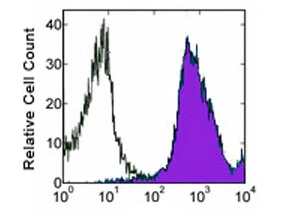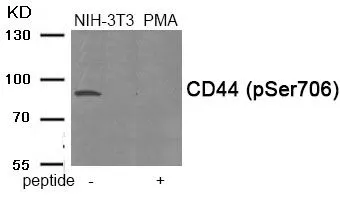![FACS analysis of human peripheral blood using GTX18243 CD44 antibody [MEM-85] (FITC). FACS analysis of human peripheral blood using GTX18243 CD44 antibody [MEM-85] (FITC).](https://www.genetex.com/upload/website/prouct_img/normal/GTX18243/GTX18243_20191025_AP_006_142_w_23060620_572.webp)
FACS analysis of human peripheral blood using GTX18243 CD44 antibody [MEM-85] (FITC).
CD44 antibody [MEM-85] (FITC)
GTX18243
ApplicationsFlow Cytometry
Product group Antibodies
TargetCD44
Overview
- SupplierGeneTex
- Product NameCD44 antibody [MEM-85] (FITC)
- Delivery Days Customer9
- Application Supplier NoteFACS: 20 microl reagent / 100 microl of whole blood or 106 cells in a suspension. *Optimal dilutions/concentrations should be determined by the researcher.Not tested in other applications.
- ApplicationsFlow Cytometry
- CertificationResearch Use Only
- ClonalityMonoclonal
- Clone IDMEM-85
- ConjugateFITC
- Gene ID960
- Target nameCD44
- Target descriptionCD44 molecule (IN blood group)
- Target synonymsCDW44, CSPG8, ECM-III, ECMR-III, H-CAM, HCELL, HUTCH-1, HUTCH-I, Hermes-1, LHR, MC56, MDU2, MDU3, MIC4, Pgp1, CD44 antigen, CD44 molecule (Indian blood group), GP90 lymphocyte homing/adhesion receptor, Hermes antigen, In(Lu) related-p80, Indian blood group antigen, cell surface glycoprotein CD44, chondroitin sulfate proteoglycan 8, epican, extracellular matrix receptor III, hematopoietic cell E- and L-selectin ligand, heparan sulfate proteoglycan, homing cell adhesion molecule, homing function and Indian blood group system, hyaluronate receptor, phagocyte glycoprotein 1, phagocytic glycoprotein 1, soluble CD44
- HostMouse
- IsotypeIgG2b
- Protein IDP16070
- Protein NameCD44 antigen
- Scientific DescriptionThe protein encoded by this gene is a cell-surface glycoprotein involved in cell-cell interactions, cell adhesion and migration. It is a receptor for hyaluronic acid (HA) and can also interact with other ligands, such as osteopontin, collagens, and matrix metalloproteinases (MMPs). This protein participates in a wide variety of cellular functions including lymphocyte activation, recirculation and homing, hematopoiesis, and tumor metastasis. Transcripts for this gene undergo complex alternative splicing that results in many functionally distinct isoforms, however, the full length nature of some of these variants has not been determined. Alternative splicing is the basis for the structural and functional diversity of this protein, and may be related to tumor metastasis. [provided by RefSeq, Jul 2008]
- Storage Instruction2°C to 8°C
- UNSPSC12352203

![FACS analysis of PBMC cells using GTX15883 CD44 antibody [Hermes-1] compared to an isotype control (blue). Dilution : 0.5 ug/test incubated for 30 min at 4oC](https://www.genetex.com/upload/website/prouct_img/normal/GTX15883/GTX15883_125_FACS_w_23060620_463.webp)
![IHC-P analysis of human tonsil tissue using GTX16728 CD44 antibody [156-3C11].](https://www.genetex.com/upload/website/prouct_img/normal/GTX16728/GTX16728_20191203_IHC-P_9_w_23060620_661.webp)

![CD44 antibody [P2A1]](https://www.genetex.com/upload/website/prouct_img/normal/GTX20051/CD44-antibody-P2A1-GTX20051-IHC-1_w_23060620_756.webp)
![FACS analysis of human peripheral blood using GTX22212 CD44 antibody [MEM-85].](https://www.genetex.com/upload/website/prouct_img/normal/GTX22212/GTX22212_20191025_AP_006_167_w_23060620_748.webp)
![WB analysis of isolated peripheral blood lymphocytes (non-reducing) using GTX29524 CD44 antibody [MEM-263]. Lane 1: human PBL lysate Lane 2 : dog PBL lysate Lane 3 : pig PBL lysate](https://www.genetex.com/upload/website/prouct_img/normal/GTX29524/GTX29524_20191025_AP_001_228_w_23060722_312.webp)
![FACS analysis of human peripheral blood lymphocytes using GTX30725 CD44 antibody [F10-44-2].](https://www.genetex.com/upload/website/prouct_img/normal/GTX30725/GTX30725_2174_FACS_w_23051500_136.webp)
